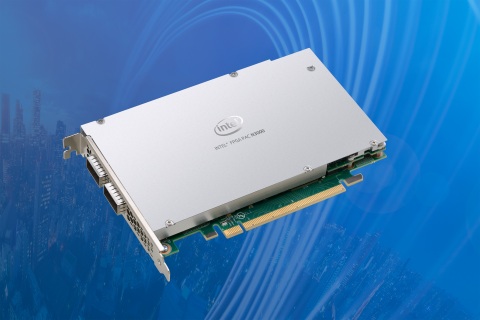BARCELONA — (BUSINESS WIRE) — February 24, 2019 — What’s New: Today at Mobile World Congress (MWC) 2019, Intel announced the Intel® FPGA Programmable Acceleration Card N3000 (Intel® FPGA PAC N3000), designed for service providers to enable 5G next-generation core and virtualized radio access network solutions. The Intel FPGA PAC N3000 accelerates many virtualized workloads, ranging from 5G radio access networks to core network applications.
This press release features multimedia. View the full release here: https://www.businesswire.com/news/home/20190224005008/en/

The Intel FPGA Programmable Acceleration Card N3000 is designed for communications service providers to enable 5G next-generation core and virtualized radio access network solutions. Intel Corporation introduced the Intel FPGA PAC N3000 at MWC 2019 in February 2019. (Credit: Intel Corporation)
“As the mobile and telecommunications industry gears up for an
explosion in internet protocol traffic and 5G rollouts, we designed the
Intel FPGA PAC N3000 to provide the programmability and flexibility with
the performance, power efficiency, density and system integration
capabilities the market needs to fully support the capabilities of 5G
networks.”
-- Reynette Au, Intel vice president of marketing,
Programmable Solutions Group
Why It’s Important: Telecommunications service providers face rapidly growing usage demands. Global internet protocol (IP) traffic is expected to increase threefold over the next five years.1 The exponential increase of mobile subscribers, internet of things devices and 5G use cases adds to the complexity and cost of network build-out and operations. Many new use cases require low latency and high bandwidth and can generate new revenue streams for the service providers while reducing the total cost of ownership.
“5G is a transformative technology, and it requires advanced network virtualization infrastructure coupled with an agile software architecture. Working with an Intel FPGA PAC N3000, we have developed a cloud-native, containerized solution for the 5G core and EPC – the first true 100G/CPU socket solution. The FPGA acceleration allows us to process this traffic load with 50 percent less CPU utilization2, providing significant room for growth,” said Ron Parker, chief architect at Affirmed Networks. “Intel FPGAs optimize software performance, lowering power consumption and latency for diverse quality of service characteristics across multiple 5G network slices.”
What It Does: Intel FPGA PAC N3000 is a highly customizable platform enabling high throughput, lower latency and high-bandwidth applications. It allows for optimization of data plane performance to achieve lower costs while maintaining a high degree of flexibility. Support of end-to end industry standard and open source tools allows users to adapt quickly to evolving workloads and standards.
How It Works: Intel FPGA PAC N3000 for networking is designed to accelerate network traffic for up to 100 Gbps and supports up to 9GB DDR4 and 144MB QDR IV memory for high-performance applications. Programmability and flexibility of an FPGA allow customers to create tailored solutions by utilizing reference IPs for networking function acceleration workloads such as vRAN, vBNG, vEPC, IPSec and VPP.
What It Delivers: Intel FPGA PAC N3000 is a fully capable end-to-end solution that can be deployed at the 5G edge and network. It is already making an impact:
- 5G core solution: Affirmed Networks* offers virtualized cloud-native mobile network solutions for 5G. By working with Intel’s FPGA PAC, it developed a new solution for 5G core network (CN)/evolved packet core – the first true 200 Gbps/server. Intel FPGAs for smart load balancing and CPU cache optimizations enhance software performance. They also provide lower power consumption and lower latency for diverse quality of service characteristics across multiple network slices for 5G. Affirmed Networks 5G Core Network will be demonstrated in the Intel booth at MWC.
- Edge: Rakuten*, a leading global innovation company in e-commerce, communications and financial technology, and soon to be the operator of Japan’s newest and most innovative mobile network, is including Intel x86 and FPGA-based PAC for acceleration from the core to the edge to provide the first end-to-end cloud-native mobile network. Intel FPGA PAC N3000 is the distributed unit accelerator next to Intel® Xeon® Scalable processor where Layer 1 functions, such as forward error correction and front haul transmission, are offloaded onto an Intel FPGA. The Intel FPGA accelerates processing efficiency to improve and support user capacity, as well as reduce system cost and provide more security in the radio network.
More Context: Intel FPGA PAC N3000 | Intel Programmable Solutions Group News | Intel at MWC 2019
About Intel
Intel (NASDAQ:
INTC), a leader in the semiconductor industry, is shaping
the data-centric future with computing and communications technology
that is the foundation of the world’s innovations. The company’s
engineering expertise is helping address the world’s greatest challenges
as well as helping secure, power and connect billions of devices and the
infrastructure of the smart, connected world – from the cloud to the
network to the edge and everything in between. Find more information
about Intel at
newsroom.intel.com
and
intel.com .








